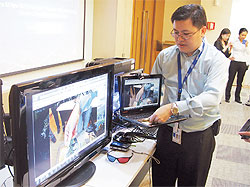World's top chipmaker branches out as technology merges,
The demand for rich experience and always-on connectivity, combined with the power of mobility, means that users are no longer limited to the personal computer, as they can take their computing experience anywhere.

Motorists enjoy an in-car infotainment system powered by Atom.
The phenomenon of "computer continuum" is driving Intel Corp, the world's leading chip manufacturer, to invest heavily in mobile and wireless broadband, transforming itself from a mere computer parts company to a computing company.
By 2015, it is expected that almost all mobile devices will be connected to the Internet and the computing capabilities of this will make computer continuum possible from servers, desktops and notebooks and further down the scale to handheld devices.
This phenomenon should fuel growth in the IT industry and encourage innovation as well as prove a catalyst for personalised computing.
These new form factor devices with computing capabilities are an emerging market. However, those devices are considered "additional" items for users, with the personal computer remaining their primary item and continuing to grow. This unit growth is expected to double within four years.
"The PC is still alive," said David McCloskey, Director of Marketing and Business Operations Platform Intel Asia Pacific.
"In Asia Pacific, the overall desktop market is still growing by double digits. For example, the lifestyle desktop has grown 15 percent, and while the business PC has grown less at six percent, notebooks and netbooks have grown at least 30-60 percent.
"There are one million PC units sold each day and in the next four years, it is expected that the number of PCs per household in countries such as the US and Taiwan will increase, although in emerging countries there are still lot of people that cannot afford to own a PC."
McCloskey added that Intel is also pushing forward with new form factor devices, especially those that use its Atom processor, on everything from netbooks to handheld devices, including smart phones and tablets, to smart televisions, in collaboration with Sony Google, to offer in-car entertainment systems.
As for the netbook market, a prototype of the world's thinnest model - at 14 millimetres - was recently showcased. It uses the Canoe Lake reference design engine platform for original design/equipment manufacturers and is 50 percent thinner than any other netbook currently on the market.
This next-generation netbook, which is expected to launch later this year, will bring Atom into the upper market.
Furthermore, early next year, the company will launch Oak Trail, an Intel Atom chip platform optimised for sleek tablets of less than 15 millimetres thickness and netbooks of less than 20 millimetres, delivering up to a 50 percent reduction in average power consumption with full HD-video playback on MeeGo, Windows 7 and Google operating systems.
In the smart phone market, which represents significant challenges for Intel, the company will port the full Internet experience from PC to smart phone, including long battery life of at least 10 days in standby mode, 3D graphics and gaming, and 1080p HD Video Playback.
Smart TV is a new category of CE Devices which seamlessly integrates broadcast TV with the Internet and personal content. The Atom CE4100 processor offers computing power, HD video and audio support, and advanced graphics to bring personal content, apps, websites and social networks to TV.

Motorists enjoy an in-car infotainment system powered by Atom.
The newly announced Google TV, a platform based on Android, is an example of a smart TV experience that offers an easy-to-use interface and unique features such as search for access to an infinite amount of content in a simple way. Sony and Logitech will be the first manufacturers to deliver Google TV-based products powered by Atom.
As for embedded computing, Atom and Core processor will collaborate on an interactive digital signage application for the retail industry, transforming advertising by use of Atom at the lowest power level of digital signage and Core i5 in mainstream performance analytics, remote manageability content blending and Core i7 processing for high performance remote content blending across large multi-displays.
The company categorises its various Atom processor series depending on segments from normal netbook - namely, N Series and D Series for entry-level desktops, Z Series for handheld devices, CE Series for smart TV, and Embedded Series for embedded devices.
Intel believes offering a choice of operating system port choices to customers will help drive the company's vision for Atom and a cross-device experience. This provides consumers with consistency and accessibility to their content across a choice of computers and PC-like devices.
Moreover, Intel will use MeeGo, an optimised Linux OS co-developed by Intel and Nokia as a "Unified Operating system" providing a common user interface across a range of consumer products to enhance the user experience, from handheld devices to in-car infotainment.
"Software is one of the important elements that helps a user experience seamless integration to access their applications and contents, no matter what their access device. This is why Intel has dedicated 20 percent of its workforce to software," said McCloskey.
He continued that the AppUp Center is a key to driving adoption of netbooks in emerging and first-time users to make applications and content relevant and meet localised needs. The AppUp Center is a content aggregator that brings content and applications from developers to netbook users faster.
The AppUp Center is still at the beta stage and is offered by both Intel, direct from the site, or its computer manufacturer partners to use under their name and help them differentiate in the pricing war. This centre will help netbook users to selects a variety of applications and give developers selling opportunities.
In the mainstream notebook market, by the end of this year, consumers will see laptops enabled with Intel Wireless Display as part of a Core i3 or Core i5 processor, which helps users take their Core processing experience to big-screen HDTV.
Consumers can quickly and securely connect the PC to a HDTV using Wi-Fi technology to create a personal area network. Users can watch the latest TV shows, news, and sports whenever they want, and bring video-sharing websites such as YouTube to life on an HDTV.
Pictures and videos can be shared with family and friends without huddling around a computer screen and personal music and Internet radio can benefit from a living room A/V setup.
Tan Guan Boon, Channel Platform Enablement Manager at Intel Electronics (Malaysia), added that users can only use a Netgear adapter to connect a HDMI port to HDTV and it will send and receive signals wirelessly from notebooks to a range of 100 meters.
At this stage, the content and applications on notebooks can appear on HDTV as "Cloning", but later it will have an extension mode that allows for different applications to be used on notebooks and to display other content from notebook to HDTV.
McCloskey also disclosed that the next-generation Intel microarchitecture, codenamed "Sandy Bridge", boasts significant advances in media and 3D graphic capabilities.
Debjani Ghosh, Director South East Asia at Intel, said since the company launched its Centrino and unwired vision in 2003, true mobility has become real as most people have multiple devices and they want to stay connected due to the popularity of social networking.
Furthermore, the Internet has become the arena of opinion, especially for the younger generation.
It's no longer just the computer that can build for growth. This is why Intel is transforming itself as a computing company providing access devices and software to deliver a seamless internet experience, no matter the platform.
About the author
Writer: Suchit Leesa-nguansuk
Position: Reporter
ที่มา: bangkokpost.com





















